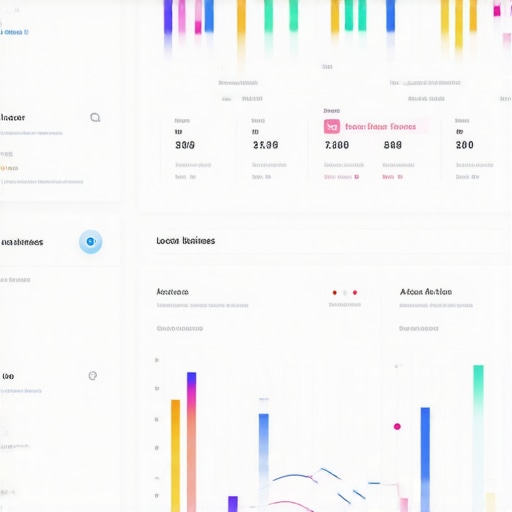Unlocking the Full Potential of GMB Strategy & Ranking Plan in 2024
As digital landscapes evolve rapidly, local SEO professionals recognize that a sophisticated approach to Google My Business (GMB) optimization is pivotal for maintaining competitive advantage. The 2024 era demands not just basic listing management but an integrated, data-driven ranking plan that anticipates algorithm shifts and consumer behavior trends. This comprehensive guide explores the nuanced layers of building a resilient GMB strategy rooted in expert insights and empirical evidence.
The Strategic Framework for GMB Dominance in a Saturated Market
How can local businesses leverage advanced ranking techniques amidst increasing competition?
In a landscape crowded with similar service providers, differentiating your GMB profile involves more than keyword stuffing. It requires deploying sophisticated local citation strategies, optimizing schema markup, and harnessing advanced SEO tactics tailored to local search intent. Analyzing competitors’ backlink profiles and leveraging Google Maps algorithm insights can generate tactical advantages. Building a cohesive reputation management system, including review automation and sentiment analysis, further consolidates authority and trustworthiness.
Deep Dive into Content Localization & User Engagement Metrics
Expert practitioners recognize that content localization—beyond mere keyword inclusion—requires cultural nuance and contextual relevance. Implementing localized content strategies enhances user engagement, directly influencing ranking signals. Coupled with behavioral analytics, such as dwell time and click-through rates, these insights refine ongoing optimization efforts. The integration of rich media, including virtual tours and 360-degree photos, elevates user experience and boosts visibility.
Can a Holistic GMB Strategy Survive Algorithm Fluctuations?
The dynamic nature of Google’s algorithms means that a multifaceted approach—combining on-page signals, off-page reputation, and technical SEO—is indispensable. Regular performance audits, utilizing tools like Google Search Console and third-party tracking software, allow proactive adjustments. From a technical standpoint, ensuring mobile responsiveness and schema integrity aligns with the latest Google core updates. As highlighted by industry experts, consistent strategy evolution is essential for long-term ranking resilience.
For those seeking to deepen their strategic mastery, exploring authoritative resources such as Moz’s local SEO guides can provide additional insights into effective Google Maps optimization techniques.
Engagement with industry peers through forums and professional networks also enriches tactical understanding and fosters innovative ideas. If you’re ready to elevate your GMB strategy, consider connecting with industry experts for bespoke consultations and ongoing support.
How can data-driven insights revolutionize your GMB strategy in 2024?
Leveraging advanced analytics tools allows local businesses to decipher intricate consumer behaviors and refine their GMB optimization strategies. By integrating data from Google My Business insights, third-party analytics, and customer feedback, businesses can craft highly targeted campaigns that resonate with local audiences. This approach not only boosts visibility but also ensures resource allocation aligns with real-world demand, creating a sustainable competitive edge.
What role does emerging technology like AI and machine learning play in GMB ranking success?
Artificial intelligence (AI) and machine learning are transforming local SEO by enabling predictive analytics and automating routine tasks. AI-powered tools can analyze vast amounts of local search data, identify patterns, and suggest actionable optimizations with unprecedented precision. For example, chatbots integrated into your communication channels can enhance customer engagement, while AI-driven review analysis helps identify sentiment trends that influence rankings. Adapting these technologies is essential for staying ahead in an increasingly digital landscape. Explore how innovative AI strategies can elevate your local search presence in 2024.
Are traditional SEO tactics enough to sustain long-term GMB dominance, or is a paradigm shift required?
While foundational SEO practices remain vital, the evolving Google Maps algorithm underscores the necessity for a paradigm shift—moving beyond keywords and backlinks towards a holistic approach encompassing user experience, trust signals, and local relevance. Implementing schema markup, optimizing for voice search, and fostering community engagement are becoming the new pillars of success. Industry experts emphasize that continuous learning and adaptation, supported by authoritative insights from sources like Moz and Search Engine Journal, are crucial for maintaining top rankings over time. To deepen your understanding and implement cutting-edge tactics, visit this comprehensive resource.
If you’re eager to exchange ideas or want personalized guidance, consider sharing your challenges or success stories in the comments below. For further reading, explore our detailed top techniques to dominate Google Maps in 2025.
Harnessing Emerging Technologies to Reinforce GMB Authority in a Competitive Market
In the relentless pursuit of local search dominance, integrating cutting-edge technological advancements is no longer optional but imperative. AI-driven tools, such as natural language processing algorithms, facilitate nuanced review sentiment analysis, enabling businesses to proactively manage reputation and tailor responses to enhance trustworthiness. Additionally, machine learning models can predict local search trends, allowing marketers to stay ahead of algorithm updates and consumer shifts. The deployment of these innovations through platforms like BrightLocal and SEMrush, which provide predictive insights, empowers local businesses to craft dynamically responsive GMB strategies that evolve with the digital landscape.
Deepening Content Localization with Hyper-Contextual Tactics
Beyond traditional localization, hyper-contextual content strategies involve leveraging real-time data and hyperlocal insights to craft content that resonates deeply with community-specific nuances. For example, integrating user-generated content, local event mentions, and culturally relevant narratives can foster authentic engagement. Such hyper-localized content not only enhances user experience but also signals relevance to Google’s E-A-T (Expertise, Authority, Trust) algorithms, thereby boosting rankings. An effective way to implement this is through dynamic content modules that update with local happenings, seasonal trends, or customer stories, creating a living content ecosystem that continually amplifies local relevance.
What are the implications of schema markup evolution on GMB visibility?
Schema markup, a cornerstone of technical SEO, is experiencing rapid evolution, with new schema types and properties tailored for local businesses emerging regularly. Enhanced schema, such as LocalBusiness and Service schema, directly influence rich snippets and Knowledge Panel features in Google Search, thereby increasing visibility. Google’s recent emphasis on structured data validation through tools like the Rich Results Test indicates a strategic move towards more precise data integration. Staying abreast of schema updates, and implementing structured data that accurately reflects your business offerings and attributes, can significantly improve GMB prominence and click-through rates. For authoritative guidance, consult Google’s official Structured Data guidelines.

How does omnichannel engagement influence GMB ranking signals?
Omnichannel engagement—integrating multiple customer touchpoints such as social media, review platforms, and direct messaging—creates a cohesive brand experience that signals active community involvement and trustworthiness to Google. When a business maintains consistent NAP (Name, Address, Phone Number) data across channels, fosters positive interactions, and encourages reviews, it enhances its local relevance. These signals are increasingly weighted in ranking algorithms, especially as Google emphasizes user engagement metrics like review volume, frequency, and sentiment. Implementing unified messaging platforms and automated review solicitation tools can streamline this process, ensuring seamless omnichannel presence that reinforces GMB authority.
Deepening Your GMB Strategy: Actionable Insights for 2024
To truly elevate your local SEO game in 2024, consider adopting a comprehensive, iterative approach that combines data analytics, technological integration, and community engagement. Regularly audit your GMB profile with tools like Moz Local and Whitespark to identify inconsistencies or gaps. Invest in local content creation that reflects community interests and seasonal trends. Utilize AI-powered chatbots to engage visitors and gather valuable feedback. And most importantly, foster genuine relationships within your local community through sponsorships, events, and collaborations—these human elements remain vital signals that underpin robust GMB rankings. As the digital landscape becomes more sophisticated, continual learning from authoritative sources such as Search Engine Land and Moz will ensure your strategies stay ahead of the curve. For tailored guidance, don’t hesitate to connect with local SEO experts who can customize a blueprint aligned with your business goals.
Harnessing the Power of Predictive Analytics for GMB Success in 2024
As the local SEO landscape becomes increasingly complex, integrating predictive analytics tools powered by AI can revolutionize your GMB strategy. Platforms like SEMrush and BrightLocal now offer predictive insights that enable businesses to anticipate algorithm shifts and consumer preferences, allowing for proactive adjustments. Understanding these trends helps craft a resilient, future-proof approach that sustains high rankings even amidst rapid digital changes.
Innovative Use of Voice Search Optimization in GMB Enhancement
With the surge in voice-activated searches, optimizing your Google My Business profile for voice queries is no longer optional. This involves incorporating natural language keywords, FAQ sections, and conversational content that align with how users speak. According to Google’s own research, voice searches tend to be more localized and intent-driven, making this optimization vital for capturing voice-driven traffic and improving visibility in rich snippets.
What are the Cutting-Edge Schema Markup Techniques Transforming Local Search?
Emerging schema types, such as LocalBusiness and Service schema, are now evolving to include structured data for attributes like sustainability practices, contactless services, and real-time availability. Google’s Structured Data Guidelines highlight that these enhanced schemas can trigger rich results, increasing prominence in local packs and Knowledge Panels. Staying ahead involves regularly updating your schema markup to reflect your latest offerings, which can significantly impact click-through rates and overall visibility.
How Can Multichannel Engagement Amplify Your GMB Authority?
Creating a unified omnichannel presence—spanning social media, review portals, and local forums—signals active community engagement and trustworthiness to Google. Maintaining consistent NAP data, actively responding to reviews, and sharing localized content across platforms reinforce your authority. Advanced tools like Hootsuite and Podium facilitate seamless management of multichannel interactions, ensuring your brand remains top-of-mind and highly relevant in local searches.
Deepening Content Hyper-Localization with Real-Time Data Integration
Hyper-local content strategies involve leveraging real-time data, such as local event calendars, weather conditions, and trending topics, to craft highly relevant narratives. For example, dynamically updating offers or blog posts based on upcoming community events fosters authentic engagement and improves E-A-T signals. Incorporating user-generated stories and culturally nuanced content further enhances local relevance, thereby boosting rankings according to recent Google algorithm updates.
How Do Evolving Structured Data Standards Impact GMB Visibility?
Advanced structured data integration now includes schema types like Product, Offer, and Event, which can be embedded directly into your website and Google My Business profile. Google’s latest Schema.org updates emphasize the importance of comprehensive, accurate data for qualifying for rich snippets and Knowledge Graph inclusion. Regularly auditing and updating your schema markup ensures your business information remains current and competitive, directly influencing visibility and user engagement.
Can Omnichannel Engagement Strategies Significantly Influence Local Rankings?
Yes, a well-orchestrated omnichannel approach that integrates social media, customer reviews, and direct communication channels creates a compelling signal of active community involvement. Consistent engagement metrics—such as review volume, sentiment, and interaction frequency—are increasingly weighted in Google’s ranking algorithms. Advanced CRM and review management tools enable businesses to automate and personalize engagement, fostering trust and authority that translate into higher local search rankings.
Why Continuous Data-Driven Optimization Is Critical for Long-Term GMB Success
Employing ongoing data analysis from sources like Google Analytics, Google Search Console, and customer feedback loops allows for refined, adaptive strategies. Regular performance audits help identify emerging trends and gaps, ensuring your GMB profile remains optimized for current ranking factors. Embracing a cycle of continuous improvement—supported by authoritative insights from Moz and Search Engine Land—empowers businesses to sustain and enhance their local visibility over time.
Expert Insights & Advanced Considerations
1. Embrace Hyper-Localization for Authentic Engagement
Leveraging real-time local data and community-specific narratives enhances relevance and signals expertise to Google, boosting rankings and trustworthiness.
2. Prioritize Structured Data Evolution
Staying current with schema markup updates like Product, Offer, and Event schemas ensures visibility through rich snippets and Knowledge Panels, directly impacting CTR.
3. Integrate Predictive Analytics for Future-Proof Strategies
Utilizing AI-powered predictive tools allows proactive adjustments aligned with emerging local search trends and algorithm shifts, securing long-term dominance.
4. Optimize for Voice Search with Natural Language Content
Adapting content to conversational queries and FAQs increases chances of feature snippets and captures voice-driven local traffic effectively.
5. Develop Multichannel Omnichannel Engagement
Consistent NAP data, review management, and cross-platform interactions reinforce local relevance signals and foster community trust, essential for rankings.
Curated Expert Resources
- Google Structured Data Guidelines: Authoritative resource for schema markup best practices and updates.
- BrightLocal & SEMrush: Leading platforms providing predictive analytics and local SEO insights for strategic planning.
- Moz’s Local SEO Guides: Comprehensive resource for deepening technical and strategic understanding of local optimization.
- Google My Business Support & Blog: Official updates and case studies directly from Google for the latest features and algorithm insights.
Final Expert Perspective
In 2024, mastering Google My Business ranking success requires a sophisticated blend of hyper-local content, evolving technical schemas, and predictive analytics—an approach that transforms traditional SEO into a proactive, data-driven mastery. Engaging with authoritative resources and adopting innovative strategies ensures your local business remains at the forefront of Google’s evolving landscape. For those committed to excellence, continuous learning and strategic adaptation are the cornerstones of sustained visibility. Dive deeper into these insights, connect with industry leaders, and elevate your GMB game to new heights—your local dominance awaits.

